By: Flatout Games Players: 1-4 Ages: 10+ Time: 30-45 mins
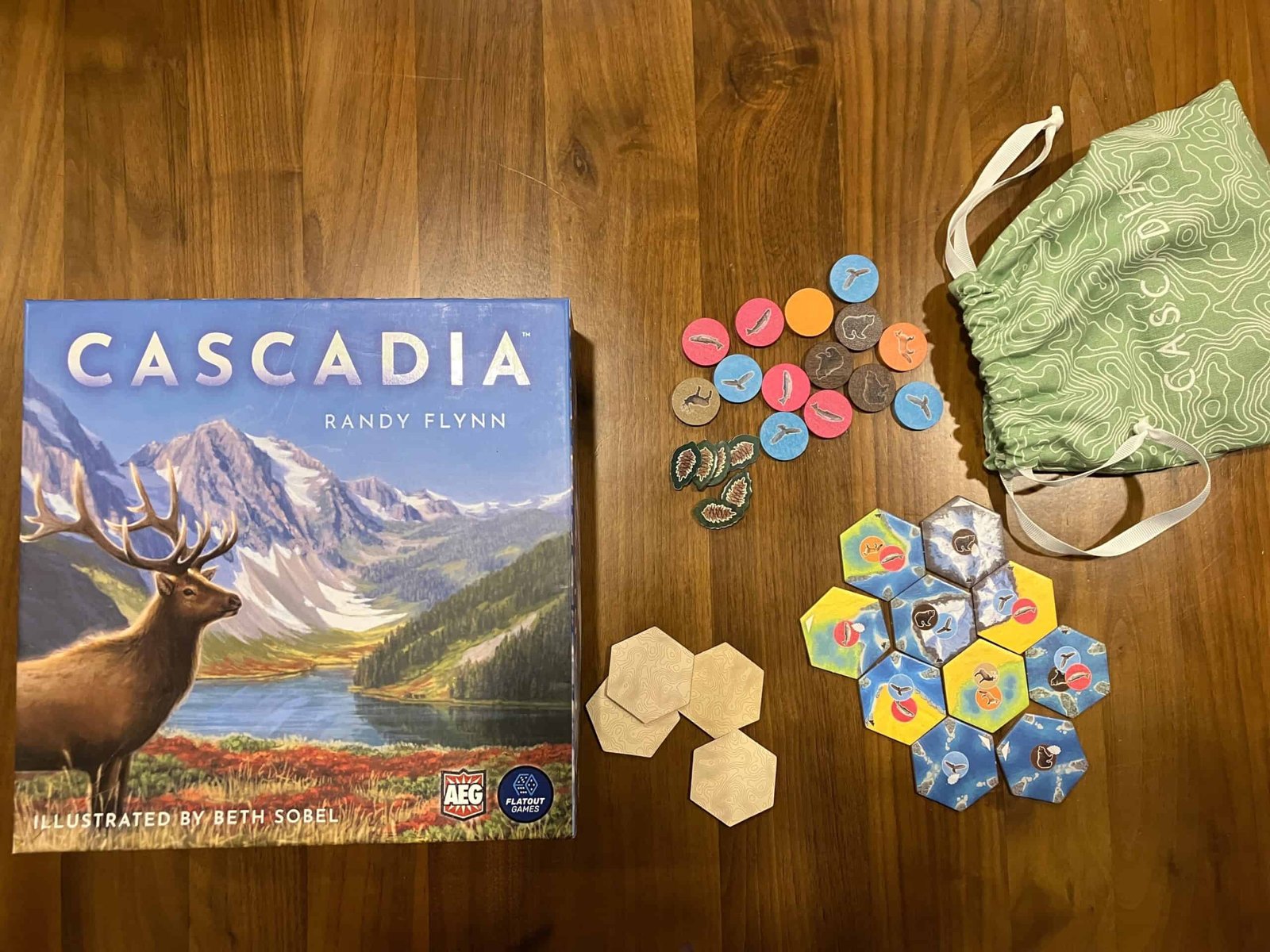
Travel to the Pacific Northwest in this tile-laying, token-drafting puzzle game featuring wildlife and habitats found in the area. Cascadia is a Flatout Games CoLab game, similar to its predecessor Calico.
Players compete to create the most diverse environment they can in the form of a beautiful landscape mosaic. Cascadia Board Game is a popular choice for game night due to its engaging gameplay and beautiful components.
With unique scoring objectives featuring the five animal species in the game, the real challenge is creating the most harmonious ecosystem possible.
What Is Cascadia? Exploring the Pacific Northwest
Cascadia Board Game is a strategy game designed by Randy Flynn, illustrated by Beth Sobel, and published by Flatout Games in 2021. Upon its release, the game was met with critical success with reviewers praising its components, accessibility, and degree of strategy. It went on to win the Spiel des Jahres (Game of the Year) award in 2022 and the 2023 International Gamers Award for best solo game.
Cascadia is based in the area known as the Pacific Northwest, which stretches from Oregon and Idaho in North America, all the way through British Columbia and the Yukon territories in Canada. Players start with three hexagonal habitat tiles and will take turns drafting tokens (representing wildlife) and tiles (representing habitats) and select one of each to add to their environment in front of them. Tiles are placed adjacent to one another, creating ‘corridors’ of habitats with animal tokens on top of them. Players aim to create wildlife corridors to score points based on the largest area of each habitat type. After all the tiles are used, the player with the most victory points, gained through a combination of clever tile and token positioning, is the winner.
Set-Up: A Flatout Games Colab Game
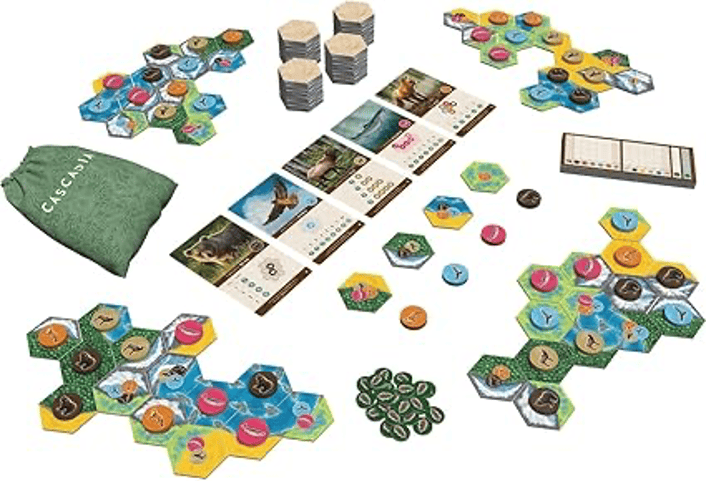
To start with, all the wildlife tokens are placed in the cloth bag and shaken up. A number of habitat tiles relative to the number of players are then randomly chosen and placed face down in a stack near everybody. The top four tiles are placed face up in the centre of the play area, along with four wildlife tokens placed with them randomly. Each of the five types of wildlife has several different scoring cards. One of these is selected for each, and those five cards are placed where everyone can see them. Everybody then takes one ‘starter’ habitat tile and the game can begin.
Players will draw a new habitat tile and place it adjacent to their existing tiles.
Players will place habitat tiles to create matching terrain and reduce fragmentation.
How To Play
Cascadia’s gameplay is very straightforward with each player’s turn only involving a couple of actions. The first thing players do is select a habitat tile and wildlife token. There will have been four pairs of these laid out at the start of the game to form random combinations for players to choose from. If ever there are four of the same wildlife token available for selection, these get put to one side and four new tiles are drawn to replace them. If there are three of the same token, the active player has the choice of wiping them and drawing new tokens or keeping them in play.
Players aim to place wildlife tokens on the appropriate habitat tiles to maximize points.
Players must choose one of the existing combinations and cannot mix and match which token and tile they choose. The exception to this rule is if the active player possesses any Nature tokens. These can be used to do one of two things: either remove any number of wildlife tokens and replace them with new ones or take any one token and any one tile of their choice from those available.
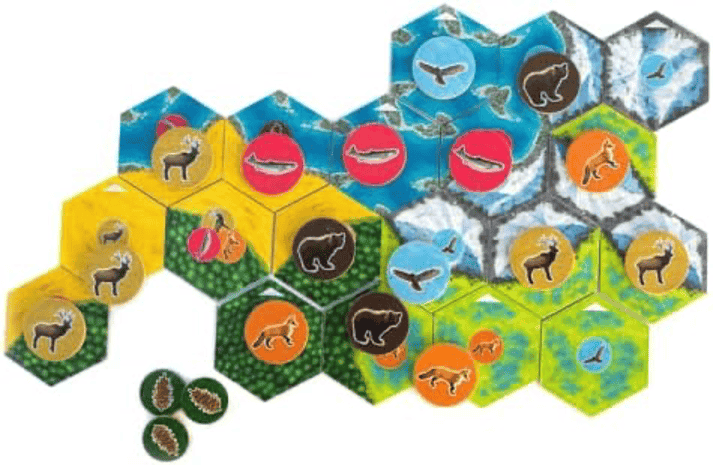
After making their selections, players will then place these components where they feel is best on their existing array of tiles. Habitat tiles must be placed simply with at least one side touching the side of a previously laid tile. Once placed it cannot be moved, and whilst there is no rule about matching terrain, doing so may impact scores at the end of the game. Only one wildlife token may be placed on a habitat tile, and that tile must also display the type of animal you wish to place on it. If a token can’t be played or a player doesn’t want to play one it is placed back in the bag. If a token is placed on a keystone tile (indicated by the symbol in the centre) then that player may take a nature token. These work as described above and there’s no limit to how many can be played each turn, but if players have any left at the end of the game they will receive bonus victory points. Once the tile and token have been played, new ones are drawn and placed with the others so there are always four pairs to choose from. Play then shifts to the next player.
Creating matching terrain is important for scoring points and creating wildlife corridors.
With only two steps to each turn, you might think gameplay whizzes by. Not so! Although the actions players can take are limited, it’s how they perform those actions and the strategy that’s implemented that makes the game as cerebral as it is! With the aspect of randomly drawing tiles and tokens, along with the combination of wildlife scoring cards being different practically every time you play, it adds a fresh challenge each time you open the box. It means that whilst you may be able to plan ahead to a degree and have an ‘idea’ of what’s to come, you can never truly be 100% prepared. The scoring cards especially add an interesting twist to the game, where no two playthroughs will score the same, which adds significantly to the replay value for future games.
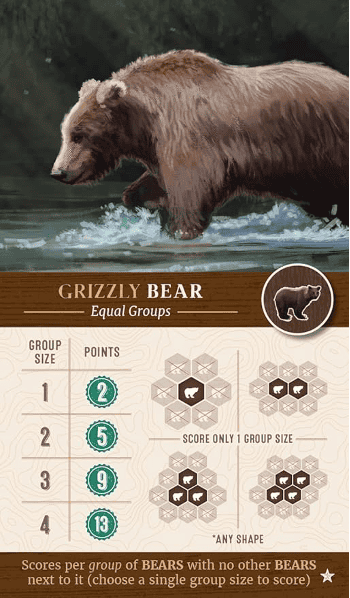
When there are no more habitat tiles left to choose from (which should be after approximately twenty turns) that ends the game and the scoring round begins. There are four different ways players can score victory points:
The wildlife scoring cards
Habitat tile corridors
Habitat tile corridor majorities
Nature tokens
Some of these factors are straightforward: players get one point for each nature token at the end of the game, one point for each of the same habitat tiles in a line, and bonus points for the player who has the longest line of each. The wildlife scoring cards are all different but essentially arranging wildlife tokens in certain ways will grant players points, and the more animals in that pattern will increase the score. Once the points have been calculated, however has score the most is the winner.
Aside from the standard multiplayer format, Cascadia offers variants on the standard rules and a solo gameplay mode also. At the back of the rulebook there are also a large variety of achievements for players to try and a tracker to use for up to five players to tick off their progress. The achievements range from easy to hard and there are several ways players can go about trying to complete them.
Landmarks Expansion:
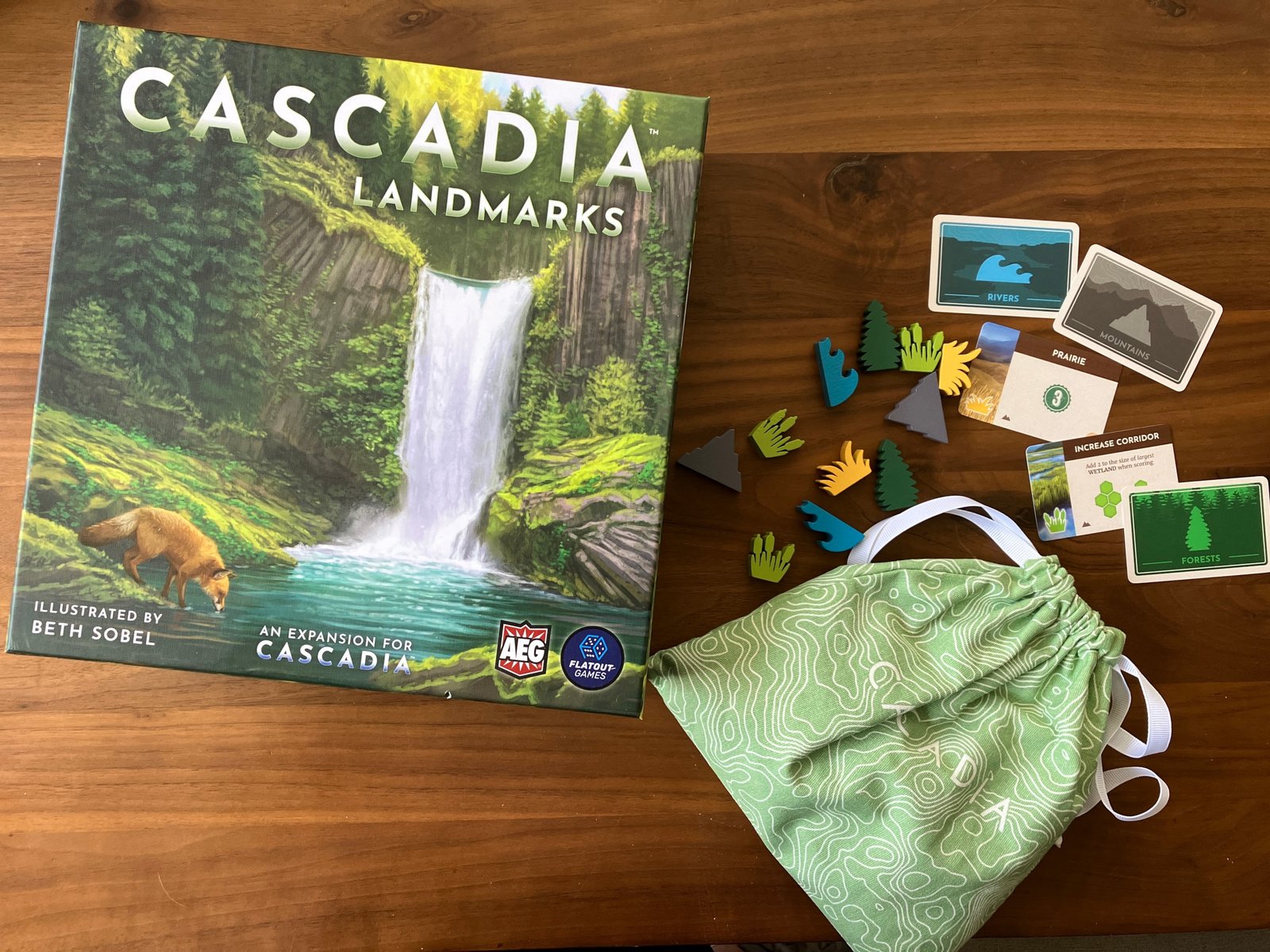
The first and best reason to pick up the Landmarks Expansion is that you get more stuff. More of everything. More tiles, more animal tokens, more scoring cards, and more starter clusters. And you can introduce all of that content, without introducing any new mechanisms. Additionally, the expansion helps create wildlife corridors by adding more tiles and tokens.
Something they also did really thoughtfully here, is that the balance of the game scales, so there is no reason I would need to separate out the new stuff, I can just mix it all together in the box and, boom, I’ve added an incredible amount of variety to a great game. That, in itself would be enough, but the game also includes two other modules:
The first module is the Landmarks module. This module adds a new type of tile to the game, the landmark tile, which provides unique scoring opportunities. Players need to consider the animals surrounding the landmarks to maximize their scores. The second module is the Wildlife module, which introduces new animal tokens and scoring cards, further enhancing the strategic depth of the game.
Increased player count rules
The expansion includes components that allow you to play up to six players. The rules also include a variant that speeds up play at higher player counts. After traditional set , you deal each player five tiles and five animals that make up their own personal market.
Once between turns, they can choose to play an animal and tile pairing from their market. This facilitates simultaneously play and makes for five fewer active turns per player. Does a great job of speeding up play and does change the strategy a bit, since you know five tiles and animals that you will have access to over the course of the game, so you can plan with that in mind.
A pretty simple addition, but a nice variant. One of the best ways I’ve seen of extending player count. I like the trend we’ve seen from this game and wingspan of making sure that they not only add players, but also keep the playtime consistent and strategic choices tight.
New Landmark Tiles and Their Effects on Hexagonal Habitat Tiles
The expansion also includes a new module with different scoring options and bonuses based around five types of landmarks you can place out on your board. Each of these Landmarks with have a different scoring condition, just like the animals in the base game.
With landmark tiles in play, players need to think more about their habitat layout. The expansion allows you to position wildlife around these landmarks, balancing the original scoring with the new landmark scoring. Each game is different and offers new ways to win.
With the Landmarks Expansion Cascadia gets more depth and more replayability for experienced players. The other stuff in the box you can add immediately, but this content is probably better if they base game has started to feel predictable or stale.
Summary
Beautiful art
Simple to digest rules
Strategy and planning are key
Multiple ways to play
Different scoring variations each game
Importance of creating matching terrain to score points and create wildlife corridors
We earn a commission if you make a
purchase, at no additional cost to you.
Final Verdict

Cascadia Board Game is a very accessible game with minimal rules that are easy to understand. It’s also incredibly well illustrated, and I wouldn’t at all be surprised if by that alone it leads people to take an interest in the Pacific Northwest and what it offers. The game relies on strategy and forward-thinking while expecting its players to be adaptable in order to score big. Cascadia has become one of the favourite games for many players due to its strategic depth and beautiful design.
There are plenty of ways to play and lots of reasons for players keep players coming back for more. With its simple-to-learn rules, endless replay value, and strategic concepts, it’s easy to see why this game was so well received upon release and is still popular years later.
Also Read: Best Board Games For 9 Year Olds
If You Liked This:
If you enjoyed touring the beauty of the Pacific Northwest and want to try out some similarly themed games, below are some we’re sure you’ll enjoy:
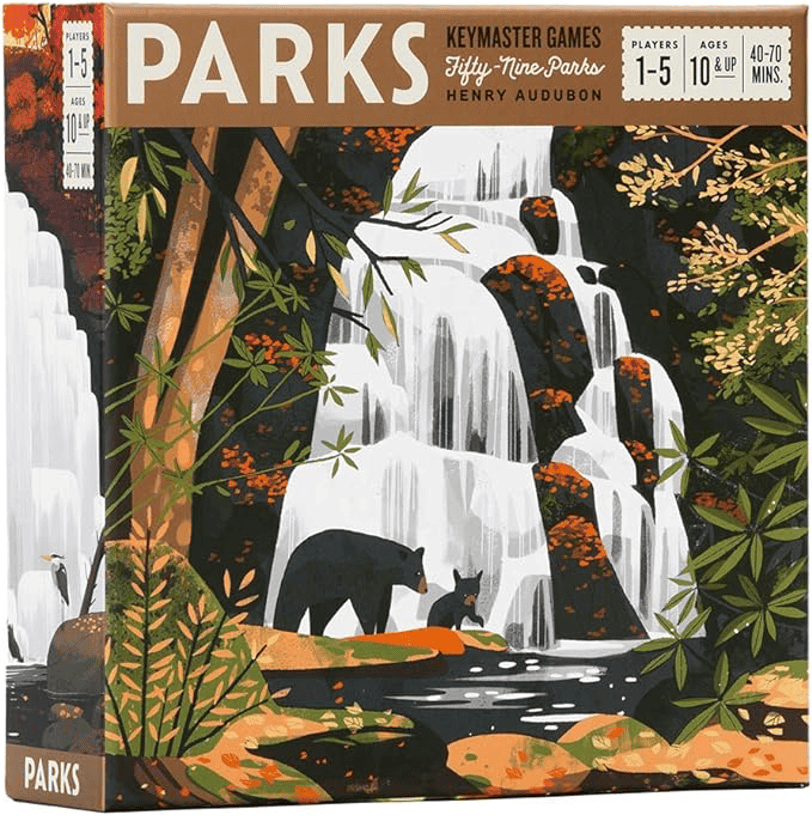
Parks: A relaxing game where players hike through trails across many US national parks during all seasons of the year. Collect memories of your travels in the form of tokens and collect sets of these memories
Barenpark: Combine tiles to create the best bear park possible. Expand your park with animal houses, outdoor areas, places to eat, and more. Utilise as much space in the grid as possible and build the best park imaginable.
Wingspan: Playing as bird enthusiasts, your goal is to discover and attract the best birds you can to your wildlife preserve. The game comes with hundreds of cards depicting all manner of birds, along with food tokens, eggs, and other well-crafted components.
Forest Shuffle: In this card game, players compete to gather the most valuable trees, then attract different species to those trees to create an ecologically balanced habitat for flora and fauna
Terraforming Mars: In the year 2400, mankind begins to terraform Mars. As a CEO of a giant corporation, it’s your job to decide how to go about doing it. Using cards and tiles, players must make wise decisions on how to go about making the red planet habitable.
FAQ: Understanding Wildlife Tokens
Q: How long does a typical game of Cascadia take?
A: A typical game of Cascadia takes around 30-45 minutes to complete, depending on the number of players and their familiarity with the game rules.
Q: What is the recommended age for players?
A: Cascadia is recommended for players aged 10 and up. The straightforward rules and engaging gameplay make it suitable for both younger players and adults.
Q: Can Cascadia be played solo?
A: Yes! Cascadia offers a solo gameplay mode with specific rules and challenges, providing a satisfying experience for solo players.
Q: How many players can play Cascadia simultaneously?
A: The game supports 1 to 4 players. The game scales well with different player counts, maintaining an engaging and competitive experience.
Q: Are there expansions available for Cascadia?
A: As of now, there are no official expansions for Cascadia. However, the base game offers plenty of variety and replayability with different wildlife scoring cards and gameplay variants.
Q: Is Cascadia suitable for casual gamers?
A: Absolutely! Cascadia’s simple rules and strategic depth make it an excellent game for casual gamers and seasoned board game enthusiasts alike.
Q: Where can I buy Cascadia?
A: Cascadia is available at most board game stores, both online and brick-and-mortar. You can also find it on major e-commerce websites.
Q: Can I play Cascadia with younger children?
A: While the recommended age is 10 and up, younger children with good reading and strategic thinking skills may also enjoy the game, especially with guidance from an adult.
Q: How much table space is needed to play Cascadia?
A: Cascadia doesn’t require a significant amount of table space. A standard-sized dining table should suffice for the game components and gameplay area.
